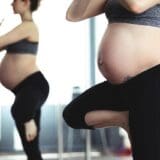During pregnancy, it is important for women to stay active and maintain a healthy lifestyle. Engaging in regular physical activity can have numerous benefits for both the mother and the baby. However, it is crucial to follow certain guidelines and take necessary precautions to ensure the safety and well-being of both.
Consulting with your healthcare provider is the first step towards staying active and fit during pregnancy. They can provide personalized recommendations based on your individual health and pregnancy condition. Discuss your exercise routine with them and get their approval for safe and suitable physical activities.
Choosing low-impact exercises is highly recommended for pregnant women. These exercises put less strain on your joints and minimize the risk of injury. Walking, swimming, prenatal yoga, and stationary cycling are some examples of low-impact exercises that can be beneficial during pregnancy.
Walking is a safe and effective exercise that helps improve cardiovascular health, boost mood, and maintain a healthy weight. It is a low-impact activity that can be easily incorporated into your daily routine. Consider taking short walks throughout the day or joining a prenatal walking group for added motivation.
Prenatal yoga is another excellent option for staying active during pregnancy. It can improve flexibility, strengthen muscles, and alleviate pregnancy discomforts. However, it is important to join a prenatal yoga class led by an experienced instructor who can modify poses according to your specific needs.
Swimming is a highly recommended exercise for pregnant women. It provides a full-body workout while minimizing the impact on your joints. Swimming improves circulation, relieves swelling and joint pain commonly experienced during pregnancy, and helps you stay cool in hot weather.
Including strength training exercises in your fitness routine is also crucial. Strength training can help build muscle strength, improve posture, and prepare your body for the physical demands of labor and childbirth. However, it is important to use proper form and avoid heavy weights or exercises that put excessive strain on your abdomen.
Listening to your body is essential during pregnancy. Pay attention to any discomfort, pain, or shortness of breath while exercising. Modify or stop any exercise that causes these symptoms. Stay hydrated and take breaks as needed to prevent overexertion.
There are certain signs that indicate you should stop exercising immediately and seek medical assistance. If you experience vaginal bleeding, dizziness, chest pain, or contractions, it is important to seek medical advice and refrain from further physical activity.
Lastly, don’t forget the importance of rest and recovery. Allow yourself sufficient rest between workouts to prevent overexertion and promote overall well-being during pregnancy. Listen to your body’s cues and give yourself the time you need to recharge.
By following these tips and guidelines, you can maintain an active and healthy lifestyle during pregnancy. Remember to always consult with your healthcare provider and listen to your body’s needs. Stay active, stay fit, and enjoy this special time in your life!
Consult with Your Healthcare Provider
Consulting with your healthcare provider is crucial when it comes to maintaining an active and fit lifestyle during pregnancy. It is important to discuss your exercise routine with your healthcare provider and get their recommendations for safe and suitable physical activities that you can engage in during pregnancy.
Your healthcare provider will be able to assess your individual health condition and provide you with personalized advice. They can guide you on the types of exercises that are safe for you and your baby, taking into consideration any pre-existing medical conditions or pregnancy complications that you may have.
During your consultation, be sure to share details about your current fitness level, any previous exercise experience, and your goals for staying active during pregnancy. This will help your healthcare provider tailor their recommendations to your specific needs.
Additionally, your healthcare provider can provide you with guidelines on how often and for how long you should engage in physical activity. They can also advise you on any modifications or precautions you should take while exercising to ensure the safety of both you and your baby.
Remember, every pregnancy is unique, and what may be suitable for one person may not be suitable for another. By consulting with your healthcare provider, you can ensure that you are making informed decisions about your exercise routine and taking the necessary steps to stay active and fit throughout your pregnancy.
Choose Low-Impact Exercises
When it comes to staying active and fit during pregnancy, choosing low-impact exercises is key. These types of exercises are gentle on your joints and help minimize the risk of injury. Here are some great low-impact exercises that you can incorporate into your fitness routine:
- Walking: Walking is a safe and effective exercise during pregnancy. It helps improve cardiovascular health, boosts mood, and maintains a healthy weight. Plus, it’s easy to fit into your daily routine!
- Swimming: Swimming is another excellent low-impact exercise option. It provides a full-body workout, improves circulation, and relieves swelling and joint pain commonly experienced during pregnancy. So, take a dip and enjoy the benefits!
- Prenatal Yoga: Prenatal yoga can help improve flexibility, strengthen muscles, and alleviate pregnancy discomforts. It’s important to join a prenatal yoga class led by an experienced instructor to ensure you are practicing safe and suitable poses.
- Stationary Cycling: If you enjoy cycling, stationary cycling is a great low-impact option. It allows you to get a cardiovascular workout without putting strain on your joints. Just be sure to adjust the intensity and resistance according to your comfort level.
Engaging in these low-impact exercises will not only help you stay active and fit during pregnancy but also provide numerous benefits for your overall well-being. Remember to listen to your body and modify or stop any exercise that causes discomfort, pain, or shortness of breath. Stay hydrated, take breaks as needed, and always consult with your healthcare provider before starting any exercise routine.
Benefits of Walking
Walking is a safe and effective exercise during pregnancy that offers numerous benefits for both the mother and the baby. It is a low-impact activity that can be easily incorporated into your daily routine, providing a gentle form of exercise that doesn’t put excessive strain on your joints.
One of the key benefits of walking during pregnancy is its positive impact on cardiovascular health. Regular walking helps improve blood circulation, which is essential for the delivery of oxygen and nutrients to both you and your baby. It can also help lower the risk of gestational diabetes and high blood pressure, which are common concerns during pregnancy.
Another advantage of walking is its mood-boosting effect. Pregnancy can bring about various emotional changes, and staying active through walking can help alleviate stress, anxiety, and mood swings. The release of endorphins during exercise can promote feelings of happiness and well-being, contributing to a positive mental state.
In addition to its cardiovascular and mood-enhancing benefits, walking can also help you maintain a healthy weight during pregnancy. It is a low-impact exercise that burns calories and helps prevent excessive weight gain. By engaging in regular walking, you can support your overall health and reduce the risk of complications associated with excessive weight gain, such as gestational diabetes and pre-eclampsia.
To make the most out of your walking routine, consider finding a walking partner or joining a prenatal exercise class. This can provide you with additional motivation and support throughout your pregnancy journey. Remember to wear comfortable shoes, stay hydrated, and listen to your body’s cues. If you experience any discomfort or pain while walking, adjust your pace or consult with your healthcare provider for guidance.
Tips for Prenatal Yoga
Prenatal yoga is a wonderful way to stay active and fit during pregnancy. It offers numerous benefits such as improving flexibility, strengthening muscles, and alleviating pregnancy discomforts. However, it is important to ensure that you join a prenatal yoga class led by an experienced instructor.
Here are some tips to make the most out of your prenatal yoga practice:
- Find a reputable prenatal yoga class: Look for a class specifically designed for pregnant women. This will ensure that the exercises and poses are safe and suitable for your changing body.
- Choose an experienced instructor: A knowledgeable and experienced instructor will guide you through the practice, ensuring proper alignment and modifications as needed.
- Listen to your body: Pregnancy is a unique journey, and your body will have different needs at different stages. Pay attention to any discomfort or pain during the practice and modify or skip poses that don’t feel right for you.
- Focus on gentle stretches and relaxation: Prenatal yoga is not about pushing your limits or achieving advanced poses. It is about connecting with your body, calming your mind, and nurturing yourself and your baby. Emphasize gentle stretches, breathing exercises, and relaxation techniques.
- Stay hydrated and take breaks: Drink plenty of water before, during, and after your prenatal yoga class. It is also important to take breaks whenever you feel the need to rest or catch your breath.
Remember, prenatal yoga is a safe and effective way to stay active and promote overall well-being during pregnancy. Enjoy the benefits it brings and cherish this special time in your life.
Swimming for Fitness
Swimming is a highly recommended exercise for pregnant women due to its numerous benefits. It is a low-impact exercise that provides a full-body workout, making it an excellent choice for maintaining fitness during pregnancy. The buoyancy of the water helps reduce the strain on your joints, making it a safe and comfortable exercise option.
One of the key advantages of swimming during pregnancy is that it improves circulation. The water pressure helps to increase blood flow throughout your body, which can help reduce swelling and alleviate common pregnancy discomforts such as swollen ankles and feet. Additionally, swimming can also help relieve joint pain, which is a common issue faced by many pregnant women.
Swimming is also a great way to stay active and maintain a healthy weight during pregnancy. It is a cardiovascular exercise that helps improve heart health and lung capacity. Regular swimming sessions can help boost your overall fitness levels and keep you energized throughout the day.
Furthermore, swimming provides a unique opportunity for relaxation and stress relief. The soothing nature of the water can help calm your mind and reduce anxiety, allowing you to unwind and enjoy a peaceful workout. It can also be a great way to connect with your baby, as the gentle movements in the water can create a sense of bonding.
When swimming for fitness during pregnancy, it is important to ensure your safety and comfort. Consider wearing a well-fitting maternity swimsuit that provides proper support for your growing belly. Additionally, remember to stay hydrated and take breaks as needed during your swimming sessions.
In conclusion, swimming is a highly beneficial exercise for pregnant women. It provides a full-body workout, improves circulation, relieves swelling and joint pain, and offers relaxation and stress relief. If you are looking for a safe and enjoyable way to stay active during pregnancy, swimming is an excellent choice.
Importance of Strength Training
Importance of Strength Training
Including strength training exercises in your fitness routine during pregnancy can have numerous benefits for both you and your baby. Strength training involves using resistance to build muscle strength and improve overall fitness. While it may seem counterintuitive to lift weights or engage in resistance exercises while pregnant, when done safely and under the guidance of a healthcare professional, it can be incredibly beneficial.
One of the key advantages of strength training during pregnancy is that it helps build and maintain muscle strength. As your body undergoes changes to accommodate the growing baby, certain muscle groups may become weaker or strained. By incorporating strength training exercises, you can target these specific areas and strengthen them, improving overall muscle tone and stability.
In addition to building muscle strength, strength training can also help improve posture. As your belly grows, your center of gravity shifts, which can lead to poor posture and increased strain on your back and joints. By focusing on exercises that target the core and back muscles, you can help maintain proper alignment and reduce discomfort.
Furthermore, strength training can also prepare your body for the physical demands of labor and childbirth. Labor can be physically demanding, requiring a combination of strength, endurance, and stamina. By engaging in strength training exercises, you can enhance your overall fitness level, making it easier to cope with the physical challenges of labor.
It is important to note that when engaging in strength training during pregnancy, it is crucial to use proper form and technique to avoid injury. It is recommended to work with a qualified fitness professional who has experience in prenatal exercise to ensure that you are performing exercises correctly and safely.
Benefits of Strength Training During Pregnancy:
- Builds and maintains muscle strength
- Improves posture and reduces strain on back and joints
- Prepares the body for the physical demands of labor
- Enhances overall fitness and endurance
Remember, always consult with your healthcare provider before starting any new exercise routine, including strength training. They can provide personalized recommendations based on your individual health and pregnancy.
Listen to Your Body
During pregnancy, it is crucial to listen to your body’s signals and adjust your exercise routine accordingly. Your body goes through significant changes, and it is essential to pay attention to any discomfort, pain, or shortness of breath that may arise during physical activity. If you experience any of these symptoms, modify or stop the exercise immediately.
One of the most important aspects of staying active and fit during pregnancy is staying hydrated. Make sure to drink plenty of water before, during, and after your workout sessions. Dehydration can lead to fatigue and other complications, so it is essential to keep your body properly hydrated.
Additionally, taking breaks as needed is crucial. Listen to your body’s cues for rest and relaxation. If you feel tired or exhausted, take a break and allow your body to recover. Overexertion can be harmful during pregnancy, so it is important to find a balance between staying active and giving your body the rest it needs.
Remember, every pregnancy is different, and what works for one person may not work for another. It is important to consult with your healthcare provider and follow their recommendations regarding exercise and physical activity during pregnancy. They can provide personalized guidance based on your specific needs and medical history.
By listening to your body and making necessary adjustments, you can maintain an active and healthy lifestyle throughout your pregnancy. Staying active can help improve your overall well-being, boost your mood, and prepare your body for labor and childbirth. Remember to prioritize your health and the health of your baby, and always seek medical advice if you have any concerns or questions.
Signs to Stop Exercising
It is important to listen to your body and pay attention to any signs or symptoms that may indicate the need to stop exercising during pregnancy. If you experience any of the following signs, it is recommended to immediately stop exercising and seek medical assistance:
- Vaginal bleeding: If you notice any vaginal bleeding during or after exercise, it is crucial to stop and consult with your healthcare provider. Vaginal bleeding can be a sign of a serious complication and should not be ignored.
- Dizziness: Feeling lightheaded, dizzy, or faint during exercise is a sign that you may be pushing yourself too hard. Stop exercising, sit down, and rest until the symptoms subside. If dizziness persists, it is important to seek medical attention.
- Chest pain: Experiencing chest pain during exercise is not normal and should be taken seriously. Stop exercising immediately and consult with your healthcare provider to rule out any underlying heart conditions.
- Contractions: If you start experiencing contractions that are regular, frequent, and painful during exercise, it is essential to stop and seek medical assistance. These contractions could be a sign of preterm labor, and it is crucial to get evaluated by a healthcare professional.
Remember, the safety and well-being of both you and your baby are of utmost importance. If you encounter any of these signs while exercising, do not hesitate to stop and seek medical advice. Your healthcare provider will be able to assess the situation and guide you on the appropriate course of action.
Importance of Rest and Recovery
During pregnancy, it is crucial to prioritize rest and recovery to ensure the well-being of both you and your baby. Allowing yourself sufficient time to rest and recover between workouts is essential in preventing overexertion and promoting overall health.
Rest and recovery play a vital role in maintaining a healthy pregnancy. When you engage in physical activities, your body undergoes stress and strain. Taking time to rest allows your muscles and joints to recover from the exertion, reducing the risk of injury and fatigue.
Overexertion during pregnancy can have negative consequences, such as increased heart rate, elevated blood pressure, and potential harm to the developing fetus. By incorporating rest and recovery periods into your fitness routine, you can prevent these risks and ensure a safe and healthy pregnancy.
Resting between workouts also allows your body to replenish energy stores and repair any microscopic damage that may have occurred during exercise. This promotes muscle growth and recovery, helping you maintain strength and stamina throughout your pregnancy.
Additionally, rest and recovery time provides an opportunity for your body to adapt to the physical demands of pregnancy. As your body undergoes significant changes, such as weight gain and hormonal fluctuations, it is important to give yourself time to adjust and recover.
Resting doesn’t mean you have to be completely sedentary. Light activities such as gentle stretching, deep breathing exercises, or prenatal massages can promote relaxation and aid in recovery. Listening to your body and giving it the rest it needs will ultimately contribute to your overall well-being during pregnancy.
In conclusion, allowing yourself sufficient rest and recovery time between workouts is essential for maintaining a healthy and active lifestyle during pregnancy. By prioritizing rest, you can prevent overexertion, reduce the risk of injury, and promote overall well-being for both you and your baby.
Frequently Asked Questions
- 1. Can I exercise during pregnancy?
Yes, it is generally safe and beneficial to exercise during pregnancy. However, it is important to consult with your healthcare provider before starting or continuing any exercise routine.
- 2. What are some low-impact exercises I can do?
You can engage in activities like walking, swimming, prenatal yoga, or stationary cycling. These exercises are gentle on your joints and help maintain fitness without putting excessive strain on your body.
- 3. How does walking benefit me during pregnancy?
Walking is a safe and effective exercise that helps improve cardiovascular health, boost mood, and maintain a healthy weight. It also enhances circulation and can alleviate common pregnancy discomforts.
- 4. Is prenatal yoga safe?
Prenatal yoga can be a great way to improve flexibility, strengthen muscles, and alleviate pregnancy discomforts. It is important to join a prenatal yoga class led by an experienced instructor who can guide you through safe and suitable exercises.
- 5. What are the benefits of swimming during pregnancy?
Swimming is a low-impact exercise that provides a full-body workout. It helps improve circulation, relieves swelling and joint pain, and offers a refreshing way to stay active during pregnancy.
- 6. Should I include strength training in my fitness routine?
Yes, incorporating strength training exercises can help build muscle strength, improve posture, and prepare your body for the physical demands of labor and childbirth. It is important to use proper form and consult with a fitness professional for guidance.
- 7. How do I know when to stop exercising?
Listen to your body and stop exercising if you experience discomfort, pain, or shortness of breath. It is important to pay attention to warning signs such as vaginal bleeding, dizziness, chest pain, or contractions, and seek medical assistance immediately.
- 8. Why is rest and recovery important during pregnancy?
Allowing yourself sufficient rest and recovery time between workouts is crucial to prevent overexertion and promote overall well-being during pregnancy. It helps your body recover, reduces the risk of injury, and supports optimal growth and development of your baby.











